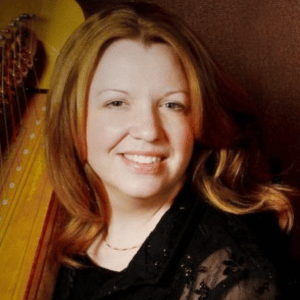With so many types of strings—nylon, synthetic, and different grades and brands of gut—how do I know what will sound best?

First, make sure the strings you choose are what are meant for your harp. What was the harp strung with when it was new and left the manufacturer? If you play a lever harp that was meant to have nylon strings, changing to gut won’t necessarily be an improvement. Making sure the gauge (or thickness) of the string is correct is of utmost importance, as the wrong gauge can cause damage to the harp. If you string a light-tension harp with strings that are too thick, the extra tension can cause the soundboard to break, the neck to twist, or worse.
Buy the best strings you can afford. I choose to string my pedal harps with gut all the way to the top, since I prefer the sound of gut and dislike the sound and feel of nylon. That is a personal preference. But the price difference between gut and nylon strings in the first and second octaves is not enough to make me cheap out on nylons.
Lastly, no matter what strings you choose, old strings will not sound their best. Once a year, before regulation, I change all the strings on my harps. The technician can do a better job regulating if the strings are new, and I sit down to what feels and sounds like a brand new harp. Bottom line: use what sounds best to you on your harp. Sound is everything and worth the expense of good strings.
—Fran Duffy

You don’t know what sounds or feels best until you have tried the strings. If you live around other harpists, try their harps and be open-minded. Ask questions about string breakage, tuning, likes, and dislikes. Buy at least a set of third-octave strings and try them a month or so before getting your harp regulated. Make a before and after recording so you objectively hear the difference, if there is any. If you like the sound or feel of one type of string better than another, then you can order a full set to restring your harp.
I initially followed what my teacher used until the strings were discontinued. I never liked nylon strings in the upper octaves, so I only use gut. Even with gut, there are variances. When I was recording my album Sketchbook of a Journey, I was not happy with my harp sound quality. Coincidentally, a new brand of gut was advertised at that same time, so I changed my strings immediately, as it was the only thing I hadn’t tried. I also scheduled a regulation. The difference was so profound with the new clear, clean sound that I had to re-record. Soon after, the strings my teacher used became available again, so I went back to those. I plan to try the new biocarbon harp strings, which are a bio-plastic derived from sugar cane. First, I’m checking with the harp tech for his thoughts, because the stringing and regulation process is different than for gut.
—Gretchen Cover

The type of strings on a harp is only one of the components that go into the sound that is produced. The other components are the harp itself and the ability of the player. To my mind, these three components are equally responsible for the sound that comes out.
Nylon strings have the lightest tension on the instrument. Gut strings have a higher tension than nylon, and carbon fiber have the highest tension, considerably higher than gut. Therefore, a harp completely strung with nylon will likely last the longest without soundboard or neck replacement.
At an American Harp Society national event back in the ’90s in Boston, I did a workshop on the sound of the harp. The point was to show that the size and quality of sound that each instrument produces is not dependent on the size of the harp, nor on the type of strings being used. I had four older harps of different sizes behind a screen, with two players playing the same short excerpts on each instrument. I then asked the audience to tell me:
1. Which harps had extended soundboards and which had straight boards.
2. Which harp was a concert grand.
3. Which was a semi-grand with an extended board.
4. Which harp was completely strung in nylon.
5. Which harp was the smallest. (It was a Lyon & Healy Style 14.)
No one guessed which harp was the concert grand. No one figured out which harps had extended soundboards. Only one person figured out which harp was completely strung in nylon. •






